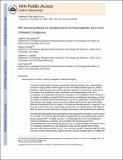MRI sensing based on the displacement of paramagnetic ions from chelated complexes
Author(s)
Atanasijevic, Tatjana; Zhang, Xiao-an; Lippard, Stephen J.; Jasanoff, Alan Pradip
DownloadJasanoff-2010-MRI sensing based.pdf (411.1Kb)
OPEN_ACCESS_POLICY
Open Access Policy
Creative Commons Attribution-Noncommercial-Share Alike
Terms of use
Metadata
Show full item recordAbstract
We introduce a mechanism for ion sensing by MRI in which analytes compete with paramagnetic ions for binding to polydentate chelating agents. Displacement of the paramagnetic ions results in alteration of solvent interaction parameters and consequent changes in relaxivity and MRI contrast. The MRI changes can be tuned by the choice of chelator. As an example, we show that calcium-dependent displacement of Mn[superscript 2+] ions bound to EGTA and BAPTA results in a T[subscript 1]-weighted MRI signal increase, whereas displacement from calmodulin results in a signal decrease. The changes are ion selective and can be explained using relaxivity theory. The ratio of T[subscript 2] to T[subscript 1] relaxivity is also calcium-dependent, indicating the feasibility of “ratiometric” analyte detection, independent of the probe concentration. Measurement of paramagnetic ion displacement effects could be used to determine analyte ion concentrations with spatial resolution in opaque specimens.
Date issued
2010-03Department
Massachusetts Institute of Technology. Department of Biological Engineering; Massachusetts Institute of Technology. Department of ChemistryJournal
Inorganic Chemistry
Publisher
American Chemical Society
Citation
Atanasijevic, Tatjana et al. “MRI Sensing Based on the Displacement of Paramagnetic Ions from Chelated Complexes.” Inorganic Chemistry 49 (2010): 2589-2591. Web. 28 Oct. 2011. © 2010 American Chemical Society
Version: Author's final manuscript
ISSN
0020-1669
1520-510X